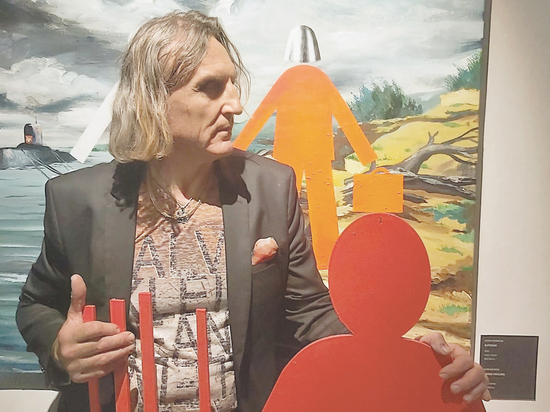Igor Novikov’s exhibition opened in Erarta
[ad_1]

“It’s interesting how Russian viewers react to the pictures, I discover a lot for myself”
An exhibition of the famous Russian-Swiss artist Igor Novikov has opened at the Erarta Museum of Modern Art in St. Petersburg. He is famous as one of the creators of pictograms – symbolic images of living beings and natural objects. Six dozen paintings and installations by the master are presented to the audience in Erarta.
Igor Novikov prefers to work in non-conformist and social art styles. The corporate style of his paintings is pictogram men, transferred to the classical plots of Levitan, Surikov, Roerich, Toulouse-Lautrec and other recognized authors.
“I started creating digitized symbolic images back in perestroika, in 1984–1985,” Igor Novikov told MK. – First men, then women, animals, nature. And now pictograms are everywhere, from toilets to art institutions. I believe that pictograms are my forte, the whole world knows them, and it’s nice to know that I came up with them. Someone, looking at my works, stomps, someone swears, and someone claps their hands and praises!
– Your little men seem to have escaped from the road signs. Why don’t they have faces?
But they do have color. Red and white, black and yellow men travel both in time and around the world. But in general, my characters can hardly be called faceless – they convey the essence of the work with their position in space, energy. Like Mayakovsky’s posters!
— By the way, why do you often turn to the work of Vladimir Mayakovsky?
— His worldview strongly coincides with my picture of the world. Let me remind you that he began his career as an avant-garde artist, creating political posters, including “ROSTA Windows”, and only then began to write poetry. As a person traveling all over the world, I put many questions to myself and to the audience: what is happening in Russia, in Europe? I root for my homeland, Russia, I am very sensitive to any negative processes taking place in my country. I ask myself questions: why is this so? – and I answer them with my works.
— Igor, there are many stories about nature in your paintings. But why are they mostly pessimistic?
“Nature is disappearing. Perhaps we are the last generation that sees her still alive, albeit on the verge of death. It is a pity that our descendants will be able to perceive the beauty of forests and fields only through paintings and photographs.
– Do Russian viewers differ from foreign ones?
– Very different! The Russian people, I think, are more spiritual and smarter. Abroad, people live more according to “framework” rules – but in our country the perception of the world comes from nature. The Russian viewer does not need to explain much, whether they are residents of small towns or megacities. On the contrary, people at my exhibitions enter into a dialogue with me, even into some kind of conflict – they say, “At first I thought that you meant this, but here, it turns out, there is a subtext.” I find it interesting how a Russian person reacts to a picture, I discover a lot for myself. Very active, very thinking people. They digest a lot in themselves … And in the West, viewers mostly look simply at the form. Relatively speaking, here is a circle, here is a square – beautiful, very interesting! By the way, I noticed that many artists who emigrated to the West began to talk less than when they lived in Russia.
— You usually exhibit in museums, but avoid galleries. What is it connected with?
“I do it consciously. Museums are eternal institutions. And the galleries were commercialized. Paintings are sold in one room, rings in another, icons in a third, and potatoes in a fourth. If only there were buyers. This is not my approach to art.
HELP “MK”
Igor Novikov was born on January 2, 1961 in the Moldavian SSR. Graduated from the Moscow State Academic Art Institute named after Surikov. Author of over a thousand works. Art theorist, philosopher, full member of the Russian Academy of Arts. His works are presented in the Russian Museum, in the Tretyakov Gallery, in the Ludwig Museum in Budapest, in the Bern Art Museum, in many collections of Russian cities. Regularly travels with exhibitions around the world.
[ad_2]
Source link






